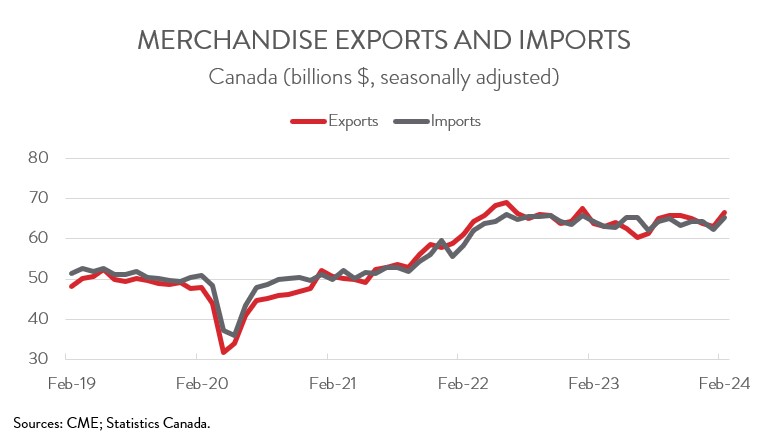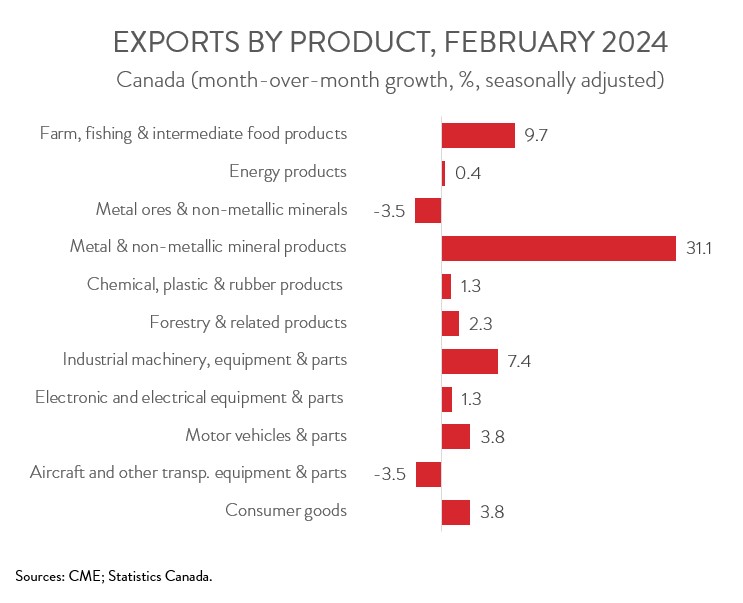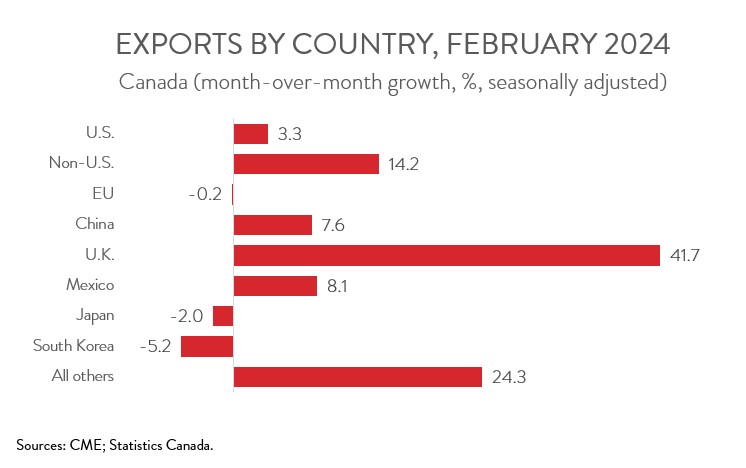International Trade
Merchandise Trade
February 2024
Canada’s Trade Surplus Widens in February as Exports Surge
HIGHLIGHTS
- Canada’s merchandise exports surged 5.8% to $66.6 billion in February, while imports soared 4.6% to $65.2 billion.
- The country’s trade surplus widened from $608 million in January to $1.4 billion in February.
- In real (or volume terms), exports and imports were up 6.8% and 3.9%, respectively.
- The increase in nominal exports was widespread, spanning 9 of 11 product sections, and was driven by record exports of gold.
- Exports to the U.S. increased 3.3% to $50.2 billion in February, while exports to the rest of the world jumped 14.2% to $16.4 billion.
- The robust February report suggests that net trade will make a positive contribution to GDP growth in the first quarter, counteracting ongoing sluggish domestic demand.
EXPORTS POST FIRST INCREASE IN FOUR MONTHS
Canada’s merchandise exports surged 5.8% to $66.6 billion in February, up for the first time since last October. Meanwhile, merchandise imports soared 4.6% to $65.2 billion, the third increase in four months. In real (or volume terms), exports and imports were up 6.8% and 3.9%, respectively.

The robust February report indicates that net trade will make a positive contribution to GDP growth in the first quarter, counteracting ongoing sluggish domestic demand, a continuation of the trends seen in the fourth quarter of 2023.
TRADE SURPLUS WIDENS
Canada’s trade surplus widened from $608 million in January to $1.4 billion in February. Digging into the details, the country’s trade surplus with the U.S. widened slightly from $8.8 billion in January to $9.1 billion in February, while our trade deficit with the rest of the world narrowed from $8.2 billion to $7.7 billion.

INCREASE IN EXPORTS DRIVEN BY RECORD GOLD EXPORTS
The increase in exports was widespread, spanning 9 of 11 product sections. Exports of metal and non-metallic mineral products increased the most, surging 31.1% to an all-time high of $9.4 billion. The growth was driven by a significant jump in exports of unwrought gold, which also reached a record level. As noted by Statistics Canada, this increase coincided with a sharp rise in the market price of gold at the end of February.
Exports of farm, fishing and intermediate food products rose 9.7% to $5.1 billion in February, up for the first time in four months and the largest monthly advance since July 2023. Wheat exports contributed the most to the growth, rebounding from a double-digit decline in the prior month.
In addition, exports of motor vehicles and parts climbed 3.8% to $8.6 billion in February. However, despite the gain, auto sector exports were still more than 5% below the levels of October and November 2023, as factory retooling continued to limit motor vehicle production in Canada.
On the downside, exports of metal ores and non-metallic minerals fell 3.5% to $2.2 billion in February, the third straight monthly decline. Similarly, exports of aircraft and other transportation equipment and parts also decreased 3.5% to $2.2 billion, down for the third time in four months.

EXPORTS TO THE U.S. SEE FIRST INCREASE SINCE LAST SEPTEMBER
Exports to the U.S. increased 3.3% to $50.2 billion in February, up for the first time in five months. At the same time, exports to the rest of the world jumped 14.2% to $16.4 billion. Among Canada’s major non-U.S. trading partners, exports to the U.K., China, and Mexico were up, while exports to South Korea, Japan, and the EU were down. The increase in exports to countries other than the U.S. was largely driven by higher exports of gold to Switzerland, gold and aircraft to the U.K., and passenger cars and light trucks to South Korea.
